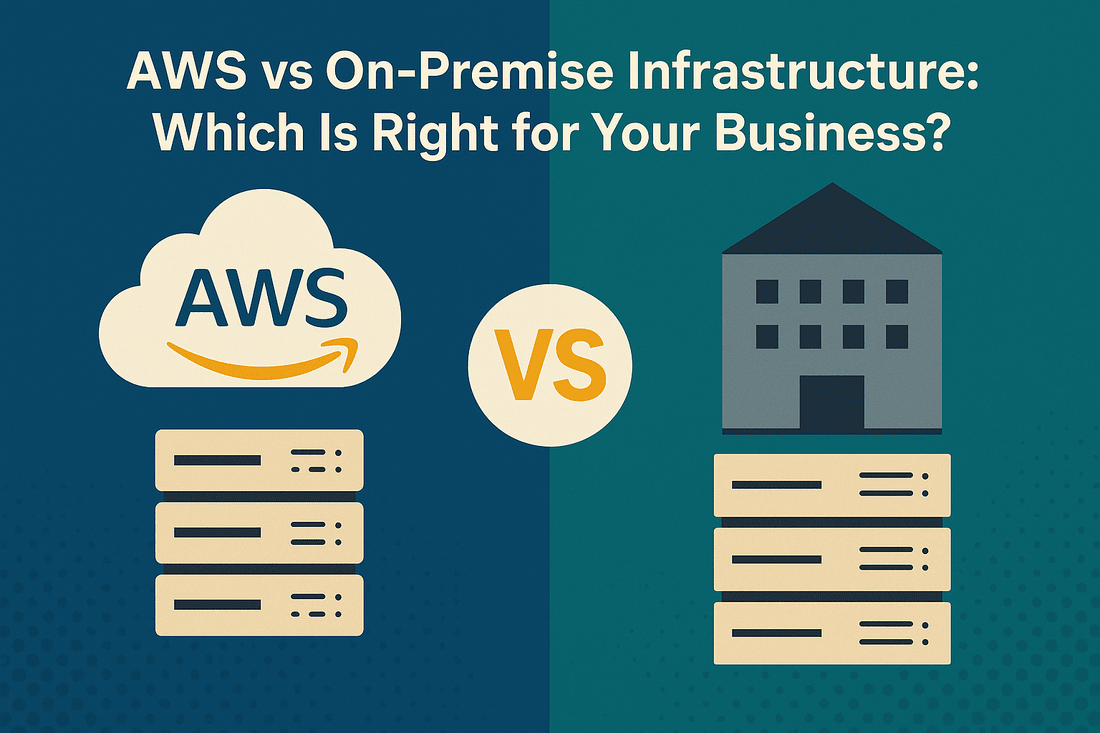Choosing between AWS cloud infrastructure and traditional on-premise hardware is one of the biggest decisions businesses face today. As digital transformation accelerates, companies are re-evaluating how they store, process, and manage data. While on-premise setups offer control and familiarity, AWS provides scalability, cost efficiency, and flexibility.
So, which option is right for your business? The answer depends on several factors, including industry compliance, long-term growth plans, security preferences, and budget. This guide will help you compare both approaches so you can make a confident, strategic decision.
What is On-Premise Infrastructure
On-premise infrastructure refers to hardware and software hosted locally within a company’s physical location. This includes servers, networking equipment, firewalls, storage, and data centers owned and managed by the organization.
Pros of On-Premise Infrastructure
Full Control
With on-premise systems, businesses maintain complete ownership of hardware, configurations, and security. This can be especially beneficial for industries with strict compliance rules, such as healthcare and government sectors.
Predictable Cost Model
While the initial investment is high, monthly operational costs can remain relatively consistent. There are no variable bandwidth or cloud service fees.
Low Latency
Since systems are physically close to users, on-premise environments can provide low-latency performance for applications that require immediate responsiveness.
Cons of On-Premise Infrastructure
High Upfront Investment
Purchasing servers, storage systems, backup solutions, and licensing requires significant capital expenditure.
Limited Scalability
Scaling requires purchasing additional hardware, which takes time and money. This makes rapid growth difficult.
Maintenance Responsibility
Internal teams must handle system updates, hardware repairs, upgrades, cooling, and physical security.
What is AWS Cloud Infrastructure
AWS (Amazon Web Services) is a scalable cloud computing platform that provides on-demand access to storage, computing power, databases, security tools, and networking services through a pay-as-you-go model.
Pros of AWS Infrastructure
Scalability and Flexibility
AWS enables businesses to scale resources up or down instantly. This is ideal for companies with fluctuating usage, seasonal demand, or rapid growth plans.
Lower Operating Costs
Businesses only pay for what they use, eliminating large capital investments and reducing long-term operational expenses.
Global Availability
AWS offers multiple data centers worldwide, making it possible to deploy applications closer to global users for improved performance.
Managed Security and Compliance
AWS includes built-in encryption, identity management, compliance certifications, and automated security monitoring—reducing the burden on internal IT teams.
Cons of AWS Infrastructure
Variable Monthly Costs
Pricing can fluctuate based on usage, storage, bandwidth, and service configurations. Without proper monitoring, bills may increase unexpectedly.
Learning Curve
Teams may require training in AWS services, monitoring tools, and governance practices.
Internet Dependency
Since AWS is cloud-based, strong and reliable internet connectivity is required.
Cost Comparison: AWS vs On-Premise
When evaluating cost differences, it’s important to consider both upfront and long-term expenses.
On-Premise Cost Breakdown
- Server and hardware purchasing
- Software licensing fees
- Physical data center space
- Electricity, cooling, and maintenance
- IT staff for upgrades and troubleshooting
- Replacement every 3-5 years
AWS Cost Breakdown
- Pay-as-you-go resource usage
- Optional reserved or spot instance pricing
- Minimal hardware management
- Automated updates and scaling
- No physical maintenance costs
For many small and medium-sized businesses, AWS offers a more affordable long-term financial model. Enterprises with predictable workloads may benefit from reserved AWS instances or hybrid environments.
Security: Cloud vs Physical Control
Security is often one of the most debated topics in the AWS vs on-premise discussion.
On-Premise Security
Businesses have complete control, but responsibility lies entirely with internal teams. This includes:
- Patch management
- Intrusion detection
- Physical building access control
- Backups and disaster recovery planning
AWS Security
AWS follows a shared responsibility model:
- AWS handles physical security, infrastructure, compliance, and network monitoring.
- Businesses manage access control, encryption settings, and data governance.
For many organizations, AWS provides stronger security due to continuous monitoring and advanced automated protections.
Migration and Execution Considerations
Moving from on-premise to AWS requires planning, assessment, and execution. Businesses must evaluate data dependencies, application architecture, and downtime tolerance before making the shift.
Many organizations follow structured frameworks such as rehost, replatform, refactor, retire, and retain during migration planning. Leveraging professional guidance and migration tools during this process can significantly reduce risks and avoid costly missteps. This is especially true when following best practices through structured AWS migration execution guidance to ensure workloads are securely and efficiently transitioned.
Which Option Is Right for Your Business?
The right choice depends on your operational priorities. Below is a simplified decision guide:
AWS May Be Best If:
- You want fast scalability
- Your workloads fluctuate throughout the year
- You need global access or remote workforce capabilities
- Reducing upfront infrastructure costs is a priority
- You’re preparing for modernization or digital transformation
On-Premise May Be Best If:
- You require full physical control and visibility
- You have extremely low-latency requirements
- Compliance limits cloud storage
- Your workload is predictable and stable for years
Hybrid Is a Growing Middle Ground
Many businesses adopt a hybrid approach, combining on-premise systems with AWS benefits. This allows flexibility while maintaining core workloads locally.
Final Thoughts
AWS and on-premise infrastructure both offer valuable advantages, but the decision ultimately depends on your organization’s long-term IT strategy, compliance needs, and financial resources. AWS provides flexibility, cost efficiency, and global scalability, making it ideal for dynamic and growing businesses. Meanwhile, on-premise solutions offer control and predictable performance, making them suitable for industries requiring strict data governance.
By understanding the pros, cons, and cost implications of both options, your business can confidently choose an infrastructure model that supports growth, innovation, and operational efficiency.

